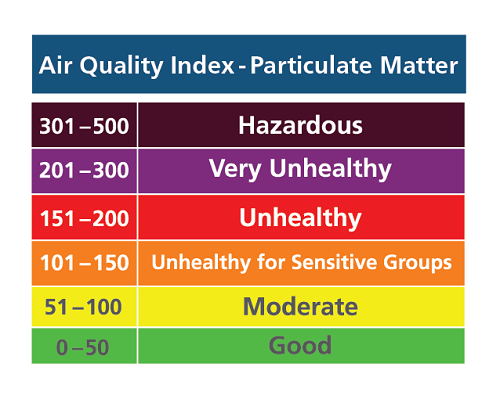Dominant Pollutant: Carbon Monoxide.
Last Updated : Hours Ago

Weather forceast-24hours (Precipitation ,Humidity, Windspeed)
What are you breathing ?
Carbon Monoxide
Allowed conc : 900 ppb
Sources :Typically originates from incomplete combustion of carbon fuels, such as that which occurs in car engines and power plants.
Effects :When inhaled, carbon monoxide can prevent the blood from carrying oxygen. Exposure may cause dizziness.
Nitrogen Dioxide
Allowed conc : 45 ppb
Sources :Main sources are fuel burning processes, such as those used in industry and transportation.
Effects :Exposure may cause increased bronchial reactivity in patients with asthma, lung function decline in patients with COPD, and increased risk of respiratory infections, especially in young children.
Ozone
Allowed conc : 40 ppb
Sources :Ozone is created in a chemical reaction between atmospheric oxygen, nitrogen oxides, carbon monoxide and organic compounds, in the presence of sunlight.
Effects :Ozone can irritate the airways and cause coughing, a burning sensation, wheezing and shortness of breath. Additionally, ozone is one of the major components of photochemical smog.
Inhalable Particulate Matter
Allowed conc : 150 μg/m3
Sources :Main sources are combustion processes (e.g. indoor heating, wildfires), mechanical processes .
Effects :Inhalable particles can penetrate into the lungs. Short term exposure can cause irritation of the airways, coughing.
Fine particulate matter
Allowed conc : 35 μg/m3
Sources :Main sources are combustion processes (e.g. power plants, indoor heating, car exhausts, wildfires), mechanical processes.
Effects :Fine particles can penetrate into the lungs and bloodstream. Short term exposure can cause irritation of the airways, coughing .
Sulfur dioxide
Allowed conc : 35 ppb
Sources :The largest source of SO2 in the atmosphere is the burning of fossil fuels by power plants and other industrial facilities. Smaller sources of SO2 emissions include: industrial processes such as extracting metal from ore.
Effects :Sulfur dioxide affects human health when it is breathed in. It irritates the nose, throat, and airways to cause coughing, wheezing.
Health Recommendations
Avoid intense activities outdoors.
Stay away from busy roads, construction sites, open fires and other sources of smoke.
Regulary meet your familly doctor and check status of your Respiratory System.
Do not travel in chaotic area.
Keep healthy diet for children.
Their lungs are still developing, and air pollution can interfere with this biological process.Their bodies are less able to metabolize, detoxify, and excrete the toxicants contained in air pollution.
Wear mask while travelling outdoor.
Stay away from raodside travel. If you develope ithing sensation or breathing problems ,visit nearby doctor as soon as possible.
Do not involve in heavy exerise.
Always keep your medications with youself and never miss prescribed medications. Keep away from vehicle ,polluted areas.
Avoid public places and do not smoke, it is injurious to your baby!
Pregnant women and children should avoid exposure to paint fumes and limit their time in freshly painted rooms.
Predictions
We try to predict concentrations of pollutants for next 12 hours from current time using our Machine learning models which are running on cloud platforms.



